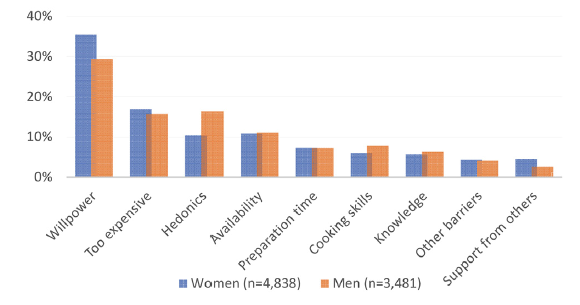Perceived barriers towards healthy eating and their association with fruit and vegetable consumption
Improving population diet is a key public health target. Poor dietary intakes have been associated with higher risk of non-communicable diseases, such as cardiovascular diseases, cancer, and type 2 diabetes, which have large health and economic consequences1. James et al. stated there is an enormous potential health gain through eating a healthier diet2. Exploring individual’s perceived barriers towards healthy eating may increase understanding of an individual’s diet, specifically fruit and vegetable consumption. This study investigates the associations between self-reported fruit and vegetable consumption and perceived barriers towards healthy eating.
The Scottish Health Survey 2008-2011
This study used Scottish Health Survey data, a nationally representative survey of Scottish households3. Data were pooled from 2008, 2009, 2010, and 2011. The Knowledge, Attitudes and Motivations (KAM) module is completed by adults over 16 years of age and includes questions on perceived barriers towards healthy eating (n=8,319). Respondents are asked to select any of the following perceived barriers to healthy eating that apply:
- a lack of willpower,
- healthy foods are too expensive,
- hedonics (healthy foods are too boring, I don’t like the taste),
- a lack of availability,
- a lack of preparation time,
- a lack of cooking skills,
- a lack of information on healthy eating,
- other barriers, or
- a lack of support from others (family, friends, colleagues).
Respondents also self-report their fruit and vegetable consumption the previous day which is dichotomised to indicate if the individual consumes the recommended 400 grams of fruit and vegetables per day, or known in the UK as “five-a-day”.
Probit regression models were estimated to test the association between meeting the five-a-day recommendation and perceived barriers to healthy eating. Separate models were estimated for men and women controlling for a range of demographic (age, location, marital status, number of children in household), socio-economic (income, education, economic activity) and lifestyle (alcohol consumption, exercise, smoking status) factors. Marginal effects were estimated from the probit models to quantify the effect of each variable.
Willpower is the most commonly reported perceived barrier to consume F&V
Twenty-one percent of men report consuming five-a-day compared to 25% of women. Figure 1 shows willpower is the most commonly reported perceived barrier in the sample followed by healthy foods being too expensive for women, and hedonics for men.
Figure 1: Proportion of respondents reporting each perceived barrier by gender

Women who reported a lack of cooking skills were less likely to meet the F&V recommendations
For women, reporting willpower as a perceived barrier to healthy eating reduces the probability of meeting the recommended fruit and vegetable intake by 3.00%. Reporting a lack of cooking skills (10.3%) and a lack of preparation time (5.6%) also significantly reduced the probability of eating five-a-day. Hedonics is the only significant barrier for both men (6.8%) and women (10.2%). Interestingly, perceiving healthy foods as too expensive was not significantly associated with consuming five-a-day despite being reported by 16.9% of women and 15.7% of men.
This analysis shows that not all commonly reported perceived barriers are associated with F&V consumption
This study gives an important insight into the relationship between perceived barriers to healthy eating and the probability of individuals consuming the recommended fruit and vegetable intake. Existing studies have identified commonly reported perceived barriers amongst populations, but this study estimates their effects on an individual’s fruit and vegetable consumption. This analysis shows that not all commonly reported perceived barriers are associated with fruit and vegetable consumption. Willpower was the most commonly reported barrier but only had a significant effect on fruit and vegetable consumption amongst women. Perceiving healthy foods as too expensive was also commonly reported barrier but was insignificant in the analysis. One possible explanation is that perceiving price as too expensive may not be a factor for fruit and vegetable consumption but may be important for other aspects of healthy eating.
Policy makers could adopt interventions…
… which address a higher proportion of the population, for example a lack of willpower in women, which may have a smaller effect on fruit and vegetable consumption. Or choose a more targeted approach, for example a lack of preparation time in women which may have a larger effect on fruit and vegetable consumption.
This work has been accepted for publication in the Journal of Public Health, doi: 10.1093/pubmed/fdw038
References
- World Health Organization. Global action plan for the prevention and control of noncommunicable diseases 2013-2020. Geneva: World Health Organization; 2013.
- James WP, Nelson M, Ralph A, Leather S. Socioeconomic determinants of health. The contribution of nutrition to inequalities in health. BMJ. 1997 May 24;314(7093):1545-9.
- Scottish Executive. The Scottish Health Survey 2011: Volume 3: Technical Report. 2012.
